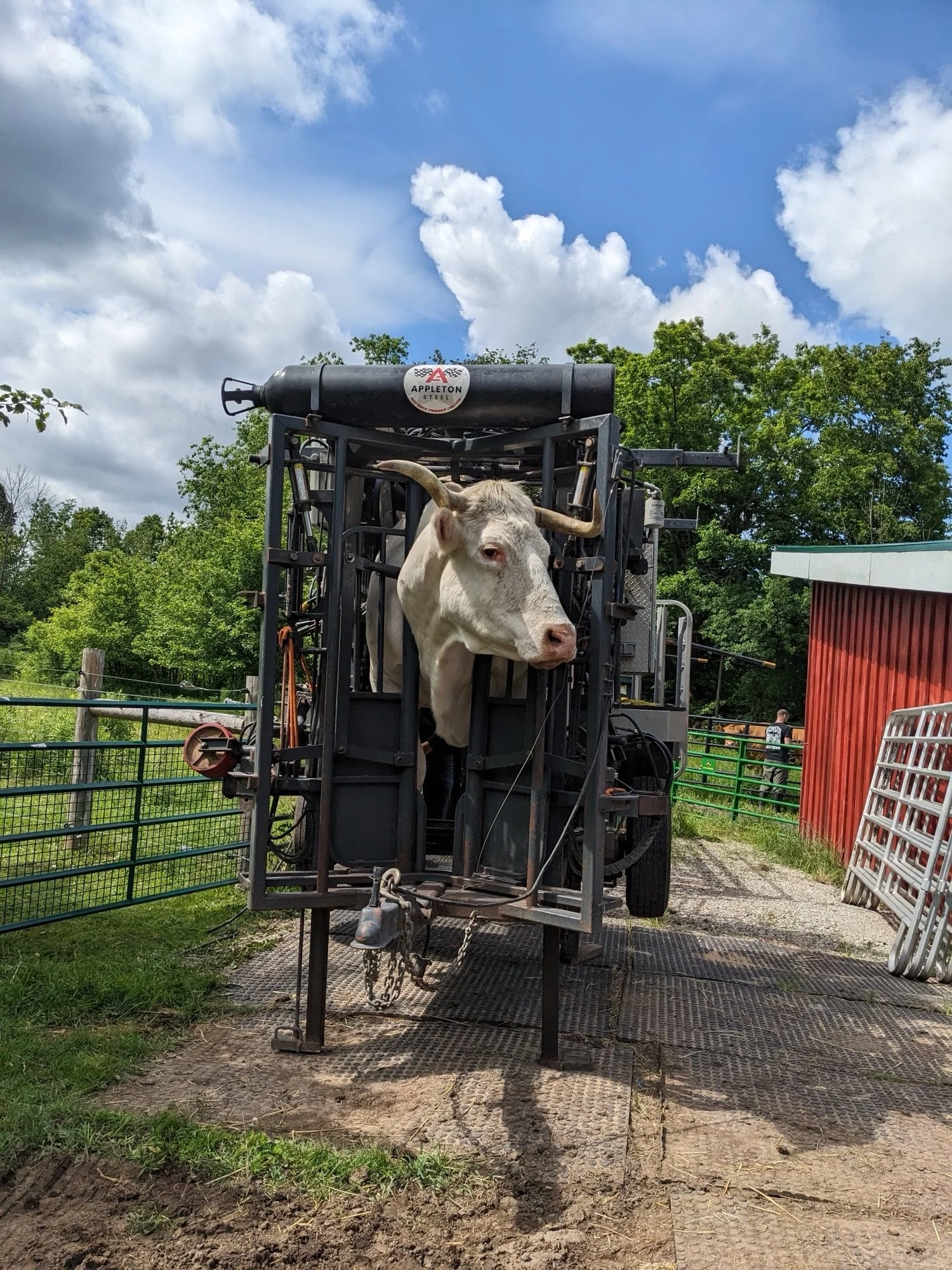THE IMPORTANCE OF HOOF CARE AT OUR SANCTUARY: ENSURING HEALTHY HOOVES FOR OUR RESIDENTS
/by Andrea White, Animal Care Manager
Over the past nine years at the sanctuary, hoof care has evolved into a cornerstone of our overall approach to resident care. As of today, we are home to forty-two hooved residents, representing 68% of our total population. That means we have 168 individual hooves to care for, which requires consistent, specialized attention and an all-encompassing care routine to ensure their health and well-being.
Denver pictured in our hoof-trimming chute
Hoof Care: A Comprehensive Approach
At HEEFS, we take a multi-faceted approach to hoof care that encompasses everything from pasture management to regular health checks and trimming. Prevention is always the goal, but it’s equally important that we are prepared for any unexpected issues that may arise. Each species of resident requires specific care, and senior residents—who make up 40% of our hooved residents—often require even more specialized attention.
Here’s a closer look at how we manage hoof care across the sanctuary.
Pasture Management
Hoof care begins before we even trim a hoof or complete a health check. Pasture management plays a vital role in keeping hooves healthy, especially during spring and the wet months. Mud can quickly lead to hoof cracks, abscesses, and infections like hoof rot, which is caused by excessive moisture, especially in goats and sheep.
Thanks to the increased space on our new property, we now have the ability to rotate pastures more frequently, something that we didn’t have the resources to do with pigs before, allowing certain areas to rest and dry out between seasons. This reduces the likelihood of hoof issues caused by damp conditions, which is particularly important for our more vulnerable residents.
Lameness Protocols
Lameness is a serious concern, particularly for our pigs, and swift action is critical when any signs of discomfort or injury appear. Our pig chute has proven to be indispensable for performing regular hoof trims, exams, and treatments. It’s been used hundreds of times over the past few years, helping us respond quickly to any concerns.
In some cases, lameness can’t be managed on-site. For example, in January 2024, our resident pig Brindle exhibited sudden signs of severe pain and lameness. We rushed him to the Ontario Veterinary College (OVC), where two sets of radiographs revealed a deep abscess in his back left lateral claw. After surgery and a week-long hospital stay, Brindle has since made a full recovery. This situation underscores how important it is to have a proactive approach and be ready for emergencies, even with regular hoof care.
Supplements for Hoof Health
In addition to daily feed, we provide specific supplements to keep our pigs’ hooves strong and healthy. Biotin and glucosamine are essential nutrients for hoof maintenance, while turmeric is added to reduce inflammation, which can exacerbate hoof issues.
Specialized Care for Larger Animals
For our equines, BJ and Escalade, regular hoof trims are necessary every 6 weeks. Thanks to the dedicated efforts of Caregiver Bailey and her specialized training program, Escalade has made great strides in his hoof care. He now receives his trims without sedation—a huge milestone for both his health and the staff who care for him.
Our cows, Denver and Pouty, also require regular hoof care. Denver is particularly prone to hoof issues such as ulcers, which have necessitated specialty care in recent years. To meet this challenge, we brought on a new cow farrier in 2024. The advanced equipment and techniques he uses have made a significant difference in the care of Denver and Pouty.
Hoof Care for Smaller Hooved Residents
For our goats and sheep, hoof trims are scheduled every 3 weeks to ensure they maintain proper hoof health. Pigs, on the other hand, receive hoof trims every 6-12 weeks, depending on the individual. For example, Sammy requires more frequent trims due to his hooves growing faster than those of his herd mates.
Looking Ahead: A Strong Foundation for Hoof Care
As we move into 2025, we are more committed than ever to providing the best possible care for all our residents. The increased space at the new sanctuary, combined with the continued evolution of our hoof care protocols, ensures that we are well-positioned to meet the needs of our hooved residents for many years to come.
Whether it’s the routine maintenance of pasture conditions or the specialized care provided to individual animals, hoof care is a critical part of the sanctuary’s overall approach to animal health. The dedication of our staff, volunteers, and supporters has made all of this possible, and we are so proud of the progress we’ve made together.
Thank you for being part of this journey with us. Together, we are ensuring that every hoof at the sanctuary stays healthy and strong.


